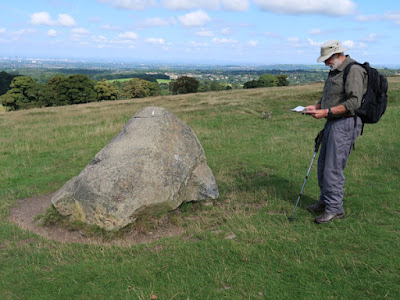 |
| A glacial erratic and The Cage |
Following on from my exploration of the Chatsworth Grit, during my walk from Baslow Edge to the Longshaw Estate, a few days later I had my last day out in August – this time to undertake a recce for a possible autumn field trip with the Sheffield U3A Geology Group to Lyme Park.
Using Rocky Rambles in the Peak District, which the group has used for several field trips, my friend Stewart had volunteered to lead a walk and, having visited it back in 1995 during a survey of Regionally Important Geological Sites in the Peak District National Park, I asked to go with him.
Of the two walks listed, we thought that the Cage Hill and Bowstones route would best serve the needs of the group and, after Stewart had picked me up from Treeton, we headed off to Disley. After waiting in a long queue at the entrance to Lyme Park, we got to the ticket booth - only to be told that we each had to pay full price for the house and gardens and that there would be no discounts whatsoever for a future group visit.
Having looked at each other with expressions of disbelief, we immediately resigned ourselves to the fact that we would not be bringing the group here. Having driven all the way from Rotherham, we decided to just make the most of the day and so forked out the excessive entry charge, parked up and set off on a sunny summer's day to look at some geology.
Leaving the car park, we immediately set off to find Locality 1, where we looked for impressions of Carboniferous plant fossils that can apparently be seen in one of the boulders of sandstone that lined the road, but weren’t able to see anything.
Our day had not got off to the best start but, walking up towards the entrance of Lyme Park mansion, we immediately found a small road cutting, where massive beds of the Milnrow Sandstone from the Pennine Lower Coal Measures Formation are well exposed.
The strike of the Milnrow Sandstone is north to south, with the dip of the strata 65 degrees to the west, with the joints at an oblique angle to the bedding planes. On the west side of the Peak District National Park, the strata are much more intensely folded and faulted than those on the eastern side, which most members of our group are more familiar with.
The specimen that I collected is light grey/brown, medium grained and with some degraded feldspar and oxidised iron bearing minerals, but with no mica. On a weathered surface, the sandstone has developed a dark brown patina.
Although the Milnrow Sandstone forms quite a distinct ridge that forms a feature on which The Cage is set, most of the bedrock in Lyme Park is covered in Devensian till, which was laid down during the last stage of glaciation in the Pleistocene period.
Walking up onto the ridge of Milnrow Sandstone towards The Cage, evidence of this glaciation is seen at Locality 2 in the form of an erratic of Eskdale granite, which is found at the edge of the Lake District National Park – a distance of over 140 km as the crow flies.
Looking closely at the granite, which is later Ordovician (Caradoc Series) in age, its principal mineral components - quartz, pink alkali feldspar and white muscovite and black biotite mica - can be quite easily determined with the naked eye.
A little further on towards The Cage, Locality 3 is another erratic from the Lake District, this time a large boulder of metamorphosed volcanic tuff from the Borrowdale Volcanic Group – a rock formation that I got to know very well when undertaking my field mapping project as an undergraduate geologist at Nottingham University.
 |
| A glacial erratic from the Borrowdale Volcanic Group |











No comments:
Post a Comment